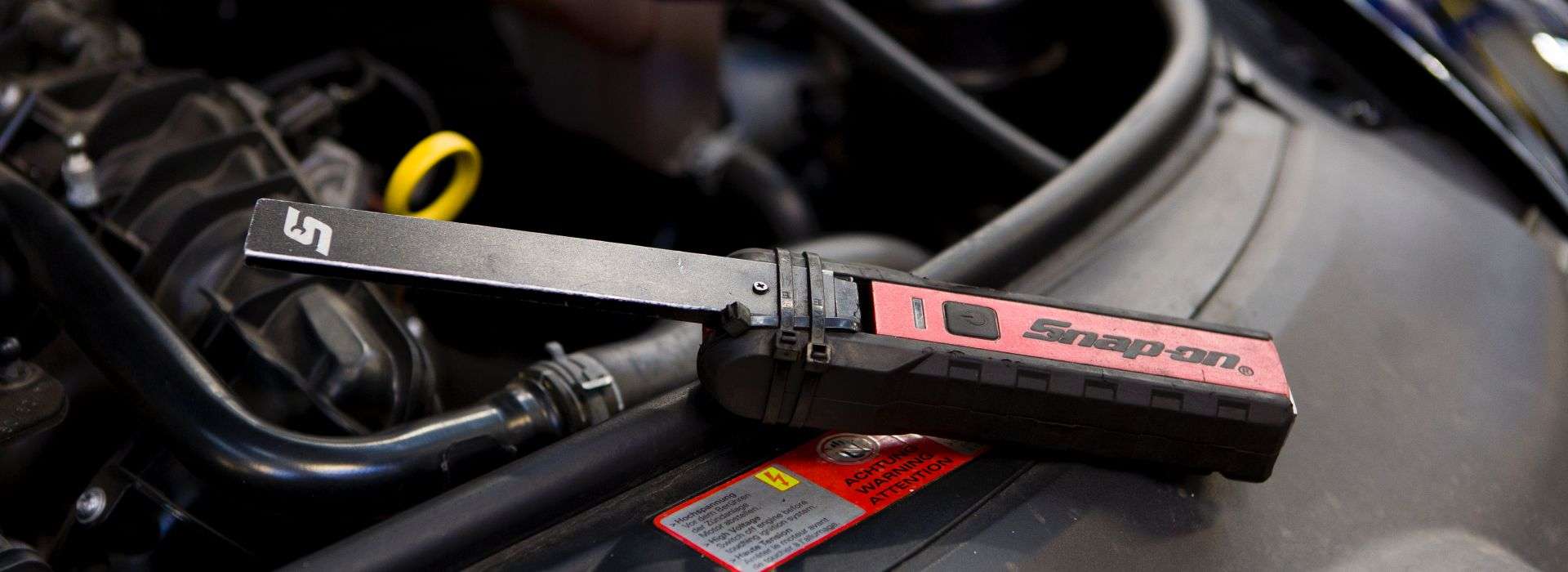How to test a car battery with a multimeter
If you are the kind of person who has a tool for everything, grab your multimeter, wear safety goggles and gloves. Testing with a multimeter confirms battery health and can hint at charging performance.
- Park safely and prepare the car: switch the ignition and lights off, open the bonnet, and let the battery rest for a few minutes.
- Set the multimeter: select DC voltage. For a standard 12 V battery, set the range to 20 V.
- Connect the red probe: attach to the positive terminal marked POS or +.
- Connect the black probe: attach to the negative terminal or a clean bare metal surface.
- Read the resting voltage: a healthy 12 V battery is about 12.6 V at rest.
- Optional running check: start the engine and read again. A working alternator usually shows 13.7 to 14.7 V.
A reading of 12.5 V or less often signals failing battery health. Book a
battery service before it leaves you stranded.
Cranking check: while starting, a healthy battery should not drop below about 10 V. Consistent drops under 10 V suggest a weak cell or failing battery.
How to test a car battery without a multimeter
No multimeter on hand? There are still a few useful checks you can do at home:
- Visual inspection: look for corrosion, bulges, cracks, or leaks on the case and terminals.
- Headlight load: with the engine off, turn headlights on high beam for 10 to 15 minutes to remove surface charge.
- Crank and observe: attempt to start the car. Slight dimming is normal. Heavy dimming, flicker, or lights cutting out suggests a weak battery.
- Listen for starting symptoms: slow cranking or repeated clicking can indicate low battery performance.
- If in doubt: book a diagnostics check or a battery service.
What voltage should a car battery have?
Use these typical thresholds as a guide for a 12 V car battery.
| Voltage reading | Condition | Action |
|---|---|---|
| 12.8 V to 12.6 V | Fully charged and healthy | No action required |
| 12.4 V to 12.6 V | Weak | Recharge and re test |
| 12.2 V to 12.4 V | Partially charged | Recharge and re test, then re measure after rest |
| Below 12.0 V | Discharged or failing | Recharge fully, re test, or replace if it will not hold charge |
| 13.7 V to 14.7 V with engine running | Alternator charging within typical range | If outside range, check the alternator |
What are the signs of a failing car battery?
- Slow cranking or repeated failed starts
- Dashboard lights flickering or dimming
- Clicking noises when turning the key
- Corrosion or swelling on the case
- Resting voltage below 12.4 V
More detail here: how to tell if a car battery is dead.
What causes a car battery to go flat?
Time is the core culprit. Most car batteries last between three and five years. Draining a battery can be as simple as leaving lights on or leaving the boot unlatched. Other factors include:
- Faulty charging system or loose alternator belt
- Faulty wiring or defective fuses
- Poor installation or loose or corroded battery cables
- Repeated short drives that prevent full recharge
- Extreme cold or heat
Not sure if it is the battery or charging system? Compare signs of a bad car battery vs alternator or read Car Alternator 101. If you already suspect the alternator, see alternator repairs.
Car battery maintenance tips
Extend battery life by minimising power use while the engine is off, avoiding long periods of non use, and taking the occasional longer trip to recharge. Top tips:
- Inspect your battery as part of your regular easy car maintenance checks
- Plan an occasional longer drive to help recharge the battery. You can even make it fun with Victoria’s best driving roads
- Have your car serviced regularly and know how to replace a car battery if required
Common car battery testing tools

- Multimeter: quick voltage checks at rest, cranking, and running.
- Battery load tester or digital analyser: assesses internal resistance and cranking performance, often reports CCA and charging system health.
- Built in indicator: some batteries include a simple state indicator window.
Frequently Asked Questions
How can I check if my car battery is still good?
Use a multimeter on DC voltage. About 12.6 V at rest is healthy. Without a meter, slow starts, dim lights, and corrosion are warning signs.
How often should I test my car battery?
At least once a year, and before winter or long trips. Test sooner if cranking is slow or you make frequent short trips.
What is the best way to test a car battery load?
Use a load tester to apply demand and watch voltage drop. A drop of more than about 1 V usually indicates a weak battery.
What are the safety precautions when testing a car battery?
Wear gloves and eye protection, work in a ventilated area, and avoid sparks near terminals. Clean corrosion before testing.
What should I do if my car battery fails the test?
Book a battery service or follow this guide to replace the battery. If readings look fine but symptoms persist, book a diagnostics check.


